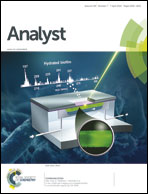Metal-enhanced fluorescent detection for protein microarrays based on a silver plasmonic substrate†
Abstract
This paper presents an ultrasensitive fluorescent detection method through fabricating a silver microarray substrate. Silver nanoparticles (AgNPs) and Ag@Au core–shell nanoparticles with different sizes were first synthesized by a seed-mediated growth method and the metal-enhanced fluorescence of these nanoparticles on different fluorescent dyes was investigated. The results indicated that AgNPs could act as a versatile and effective metal-enhanced fluorescence material for various fluorophores, whereas the enhanced fluorescence from Ag@Au was limited only to certain fluorophores. When the AgNPs were functionalized with aptamers and fluorescent dyes, a good analytical performance for simultaneous detection of human IgE and platelet-derived growth factor-BB (PDGF-BB) could be obtained. AgNPs were not only used as detection tags but also used to fabricate the plasmonic microarray substrate to further enhance the sensitivity of fluorescent detection. As a result, a linear response to PDGF-BB concentration was obtained in the concentration range of 16 pg mL−1 to 50 ng mL−1, and the detection limit was 3.2 pg mL−1. In addition, the AgNP modified plasmonic microarrays showed remarkable recovery and no significant interference from human serum when applied to 2 ng mL−1 PDGF-BB concentration. The plasmonic microarray substrate demonstrated both high specificity and sensitivity for protein microarray detection and this novel approach has great potential for ultrasensitive detection of protein biomarkers in the bio-medical field.


 Please wait while we load your content...
Please wait while we load your content...